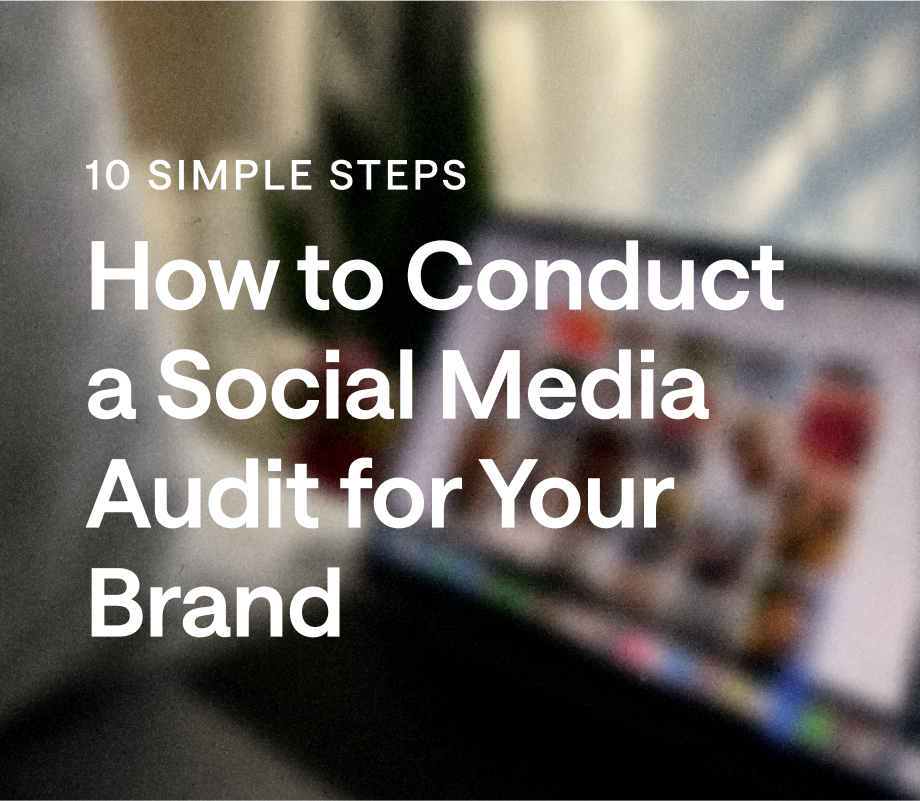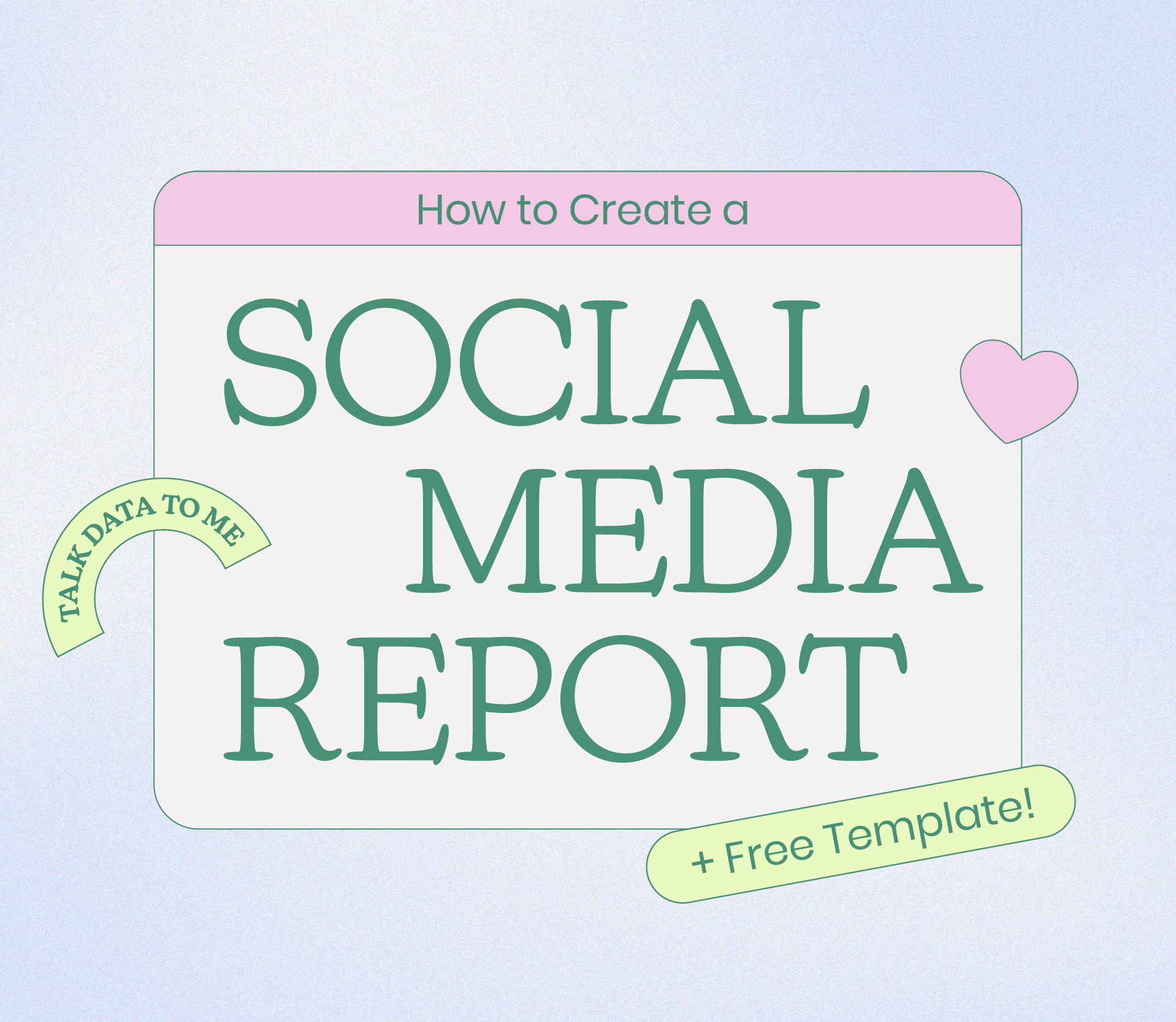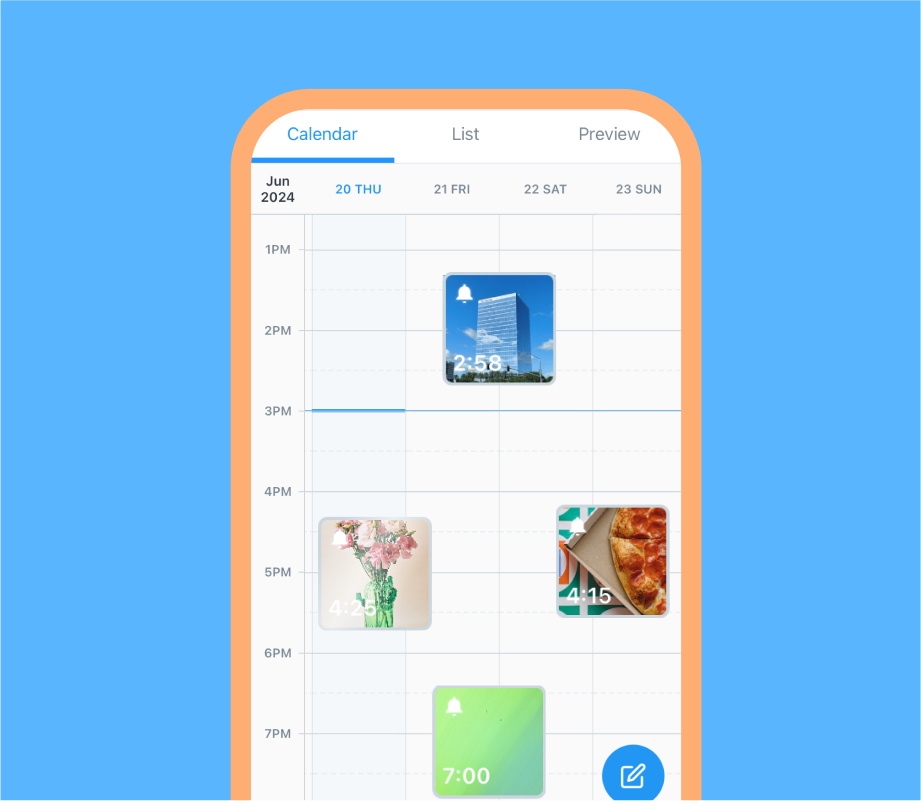Social media can be one of the most successful ways to promote your brand, but it requires a significant amount of time and effort. If content on certain platforms or in specific formats isn't performing as well as it could be, it's vital to know where you can make improvements and get the most out of your resources. A social media audit can help you determine whether your content is achieving your goals and identify areas for improvement.
Make every post count—use Later to run smarter social audits and optimize your content strategy for better results. Try it free for 14 days.
Table of Contents
- What is a social media audit?
- What are the benefits of a social media audit?
- How to perform a social media audit in 10 simple steps
- How to conduct a social media audit using Later Social
- Get your free social media audit template & more
- Social media audit examples
- What social media audit tools should I be using?
- Get better insights with Later
Join over 1 million marketers to get social news, trends, and tips right to your inbox!
Email AddressWhat is a social media audit?
Companies need to gauge how their social media presence across all platforms is advancing their business objectives. An audit evaluates a brand's digital footprint, identifying areas for improvement, optimizing resource allocation, and refining analytics tracking to reach goals more efficiently.
Social media audits look at the following areas:
Account performance:
The reach of the current social media strategy and how effectively it is achieving key performance indicators (KPIs)
Branding consistency:
The brand's uniformity in terms of tone, messaging, and visuals across platforms and media
Audience behavior:
Understanding your audience demographics, behavior patterns, and preferences to create more targeted content
Traffic flow:
Tracking how the different social media platforms and strategies drive customers to the sales funnel
Content effectiveness:
Determining which formats and platforms perform better and which are taking up resources with few results
Regularly inspecting your social media presence is crucial for guaranteeing you're on track to meet your goals. Social media audits allow you to quickly spot content gaps, missed opportunities, and areas of weakness that can have positive effects when fixed. This data allows companies to make better strategic decisions and forecasts for their marketing campaigns and overall social media strategy.
What are the benefits of a social media audit?
Social media is a cost-effective way to grow, engage, and sell to global audiences — but if you're not using it right, it's a waste of resources. Social media audits allow you to systematically analyze your current efforts for maximum effect, offering many advantages:
Aligns your content with your brand goals
Highlights chances to improve engagement and reach
Makes reporting and optimization easier
Supports budget allocation and content planning
Uncovers gaps and untapped opportunities
Shows you how you compare to competitors
Finds solutions to important marketing issues
There are different ways to conduct an audit and reap these benefits. Companies can hire a professional or agency, leverage a platform such as Later, or use analytics tools to take the task on themselves.
How to perform a social media audit in 10 simple steps
To carry out your own social media performance audit, follow these basic steps.
1. Take inventory of active and inactive social profiles
The first step is to create a centralized list of all your social media accounts, including those that are inactive or used infrequently. List out usernames, URLs, and account owners to keep the details organized.
You'll use this information during your audit, and it also highlights what you may be missing. For example, if you haven't created an account on a newer social media platform, such as Threads, it will be obvious when it's not on the list.
It's also a good idea to search platforms for unofficial accounts that use your brand name. Whether these accounts are impostors or coincidences, they can hurt your brand's reputation. Misleading or inappropriate posts can damage your public image, and potential customers could interact with the wrong accounts, leading to missed opportunities. Report any accounts that infringe on your intellectual property to maintain control of your brand's online footprint.
Having multiple accounts is an essential practice in the current social media marketing landscape, but it can be difficult to manage. Tools like Later's calendar and profile switcher make it easier to manage all of your social media touchpoints from one place.
2. Define specific goals for each network
Determining how your social media goals help you achieve broader organizational objectives is the next step. Each platform offers different opportunities, so understanding their strengths and choosing the most effective places for different types of content helps you attain success faster. For example:
YouTube:
Long-form videos can educate your audience about products and services.
X:
Brief posts let you easily give real-time updates to followers.
Instagram:
Reels, stories, and carousels offer countless changes for engagement.
LinkedIn:
Posts bring brand awareness to professional audiences.
TikTok:
Virality on this platform can lead to free brand visibility.
Facebook:
This social media staple is excellent for community building and fostering customer loyalty.
Threads:
Engaging posts on Threads can drive conversations and traffic to other pages and sites.
With clear goals mapped out, you can determine which platforms to allocate more resources to. Most companies will want to engage their audiences on multiple social media platforms for optimal results. Using Later's content calendar helps you easily organize and post on various accounts and channels from one centralized location.
3. Check for brand consistency across platforms
Keeping a uniform style and tone across all platforms minimizes confusion and reinforces brand identity. You'll need to check that your overall messaging is consistent with your style guide and that features like profile pictures, colors, and bios match. Verifying your usernames are consistent across platforms makes it easier for users to locate and trust your accounts.
You'll also need to check that links and URLs work and are up to date. Using Later's Link in Bio tool is an easy solution to make your content clickable and easier to find. By incorporating this customizable mini webpage into your brand's bios on platforms like Instagram, TikTok, and Snapchat, you'll be able to track sales and direct users to your website and mailing lists. The tool also allows you to handle all links through one platform.
4. Open up your social media analytics
To understand what's working and what isn't, use social media analytics tools from Later or the native platform to track and analyze key metrics. Useful KPIs to take note of include:
Impressions:
The total number of times users saw your content, including repeat views
Engagement rate:
The percentage of users who interact with your content
Reach:
The number of unique viewers for each post or video
Click-through rate:
The percentage of people who choose to view your content
Vanity metrics:
Counts such as likes, shares, subscribers, comments, and views that indicate how popular your content is
These metrics allow you to track progress and determine results. Use this insight to make data-driven decisions on which areas to focus your efforts.
5. Identify your top-performing content
Review all of your social media channels, but pay particular attention to those you plan to invest more resources in. Find the top posts and note the links so you can look over them later.
Pay attention to the platforms, formats, and content types that are getting the results you want. Remember, an X post with a lot of likes might not be as valuable as a less-liked post that brought about more conversions. Determine which metrics are most important to achieving your goals and base your top performers on those.
Study the posts, videos, and other content that have done the best, looking for similarities that equate to success. You can then use high-performing content as a template for future success. For instance, if an Instagram Carousel performed very well, you can use Later's caption generator to replicate the voice used in the text for other Instagram posts or other channels.
6. Map out your traffic funnel
Carefully coordinating your social media strategy helps you build an effective marketing funnel. Plot out the journey a potential customer can take from finding out about your brand to making a purchase.
For example, you can spread brand awareness and expand your visibility through TikTok posts. When viewers interested in your engaging content want to learn more, they go to your profile page. There, they can click on the "Link in Bio", which directs them to a landing page offering a free newsletter sign-up. Once they sign up for the newsletter, you can send them information and promotions directly via email to encourage them to purchase your product or service.
There are various ways a traffic funnel can generate leads and conversions. Map out appropriate strategies for each social media channel and make adjustments as needed to get the results you want.
7. Analyze audience demographics
During your audit, you may be surprised by how each platform's demographics differ. It's crucial to study the data and realize who you are promoting your brand to for each social media platform.
Each platform's native insights combined with Later's tools can help you determine crucial metrics such as the age, region, interests, and behaviors of your viewers.
8. Evaluate new platform opportunities
Tech companies are constantly developing new platforms, and you never know which one will be popular in the future. At the very least, choose a username that aligns with your brand on each one. Consider whether these new platforms align with your overall goals and fit the content you produce.
Be open-minded and look for opportunities that can unlock new audiences. You can often repurpose content from one platform to create a presence on a different platform. For example, if you want to give Pinterest a try, you can find pictures that you've previously posted on Instagram and Facebook to get your account off the ground and see where it goes.
9. Set updated objectives and content actions
With the data gathered from your social media audit, you can begin pursuing new routes and strategies. You'll now have insights into your current strengths and weaknesses that you can use for direction.
Set platform-specific priorities and KPIs to keep yourself on the path to success. Also, look into helpful tools such as Later's social media content calendar to optimize workflows and use fewer resources.
10. Share your audit with your team
For the new strategies and content to be effective, everyone involved needs to know the results of the social media audit. Create a one-page summary that details all of the metrics and findings across platforms.
Assign actionable steps for team members to follow to start down the new path. To optimize your new workflow, use Later to schedule future posts based on the data-driven insights you've uncovered with the audit.
How to conduct a social media audit using Later Social
Conducting a social media audit can be a time-consuming process if you're doing it on your own. Luckily, Later Social has tools and features that make the audit process significantly easier, saving you time while giving you the accurate information you need.
1. Access your analytics dashboard
On Later's analytics dashboard, you can track social media performance across platforms, including Facebook, TikTok, Instagram, and X. View everything from engagement rate to reach and top-performing posts in one place, eliminating the need to hop from platform to platform to gather information.
2. Filter reports by platform, date range, and post type
Later Social makes it easy to refine your data further and find the exact info you're looking for. In the dashboard, you can filter reports by the social media platform, format, and date to get more insights.
For example, by filtering for date and time of day, you may find that Reels perform better earlier in the day while your target audience is taking a lunch break, while long-form YouTube videos get the most watch time on Thursday nights. This can help you optimize when to post for maximized results.
3. Identify your top-performing content at a glance
Later Social lets you find your top-performing content across channels fast. You can compare KPI metrics from your highest- and lowest-performing content to find ways to improve.
Keep an eye on which topics, formats, captions, and posting times get the most engagement and boost from the algorithms. This information makes it easier to refine your approach and spend more time on what's working.
4. Automate, export, and share reports
Later's analytics tools do more than just show you data. You can also create and export reports in seconds. Easily customize the information you want included and schedule times to have Later automate and send the reports out. This feature is perfect for sharing data with clients and team members to keep everyone on the same page.
5. Use insights to improve your strategy
Analytics are most useful when you can make seamless changes to capitalize on what you've learned. Tools such as Later's content calendar make it easy to visually map out when content will go out in which format and on which platform.
Maximize your results with Later's best time to post tool, which takes your audience into account and determines the most strategic times for sharing content. Hashtags also help the users you want to reach find your content, so using the right tags is pivotal for success. Later's Hashtag suggestions give you ideas and analytics so you can find the best ones.
Get your free social media audit template & more
Auditing your social media from scratch is challenging, and it helps to have guidance. Later offers a wide variety of downloadable resources, including templates, worksheets, and specific social media audit checklists so you can step up your social media game.
Search for whatever area you need help with, such as audits, strategy, or performance tracking. Use the free materials to hone your social media strategies and get ahead of the competition.
What social media audit tools should I be using?
When conducting a social media audit, employing the right platforms and tools makes the process faster and easier.
Later (recommended)
Later's platform conveniently consolidates all your social accounts into one place. You can access a variety of specialized tools to schedule, analyze, and track your content. Conduct audits with ease, whether you're an individual creator, marketing team, or creative agency. In addition, Later Social has other tools like best time to post, hashtag suggestions, and a content calendar to make your social media process as efficient as possible.
Google Analytics
Google Analytics is a free service that gives insights about how users interact with apps and websites. This is an excellent resource for understanding where users who end up on a landing page came from. It also gives insights into user behavior, such as how long they stay on a web page, what they look at, and how many conversions you're getting.
Meta Business Suite/TikTok Analytics
Most platforms have native analytics that can be helpful. For example, you check your metrics from Facebook and Instagram on Meta Business Suite, TikTok on TikTok Analytics, and YouTube videos on YouTube Studio.
While this is a good starting point, brands running multiple accounts will need to switch back and forth between platforms to compare content and KPIs. The native analytics are also often very basic, making it difficult to gain a thorough understanding of how to optimize your strategy for better results.
Get better insights with Later
A social media audit is an excellent way to assess your current approach and content, then use the findings to refine and achieve your goals more efficiently. Whether you plan to conduct in-depth audits quarterly or perform quick analytics checks multiple times a week to gauge your progress, using an advanced social media management platform like Later Social can save you time and money while helping you reach your goals.
Later's bundle of tools and features helps both businesses and individuals improve their digital footprint. This convenient platform brings all of your social media accounts and channels together in one place where you can schedule posts, manage media, and analyze performance.
Want to save time and get better results with your content? Start your free trial of Later Social and take control of your content, analytics, and strategy today!





Social media audit examples
Different types of social media audits allow you to focus on what you particularly need to succeed. Here are three examples of how you can use an audit to shape your social media strategy to help you decide what's best for your brand.
Example #1: In-depth quarterly audit
A comprehensive social media audit done every three months can help you not just maintain but grow your brand's online presence. This type of audit requires analyzing all metrics for each platform individually and benchmarking the results against the previous audit. Make sure bios, posts, videos, and styles are consistent across platforms, and all URLs and links are active.
Example #2: 30-minute performance check
A 30-minute performance check is a quick glance at your analytics to see how things are tracking. You might schedule a specific time to do this, such as every Monday afternoon, or run these checks multiple times a week. By regularly reviewing key metrics and top-performing content, you can determine in real-time how well your content and strategy remain aligned.
Example #3: Agency audit for multiple brands
If you run a marketing agency, you may need to run audits for several brands that you manage at the same time. These audits are often standardized through templates, providing an overview of each brand's analytics. Agencies can review client-specific goals and determine whether their current content positions them to achieve them. These multi-brand audits also help an agency notice overarching trends and recommend changes based on these findings.